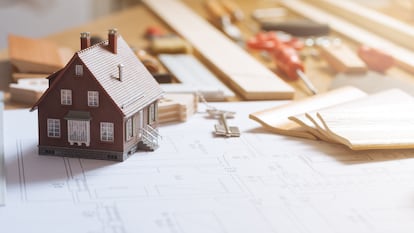From the sports car to the apartment in the center: now the ‘influencers’ boast about housing as a luxury item
Social media stars no longer show off their Loewe bags or Lamborghinis, but rather the aseptic apartments in which they invest. They are directing their money towards a refuge value that is, at the same time, something with a lot of social value: housing

YouTube has been filled with bizarre characters who drive sports cars (often Lambos, which are especially ostentatious), get up early in the morning to attend to their business (although it’s never entirely clear what that entails) and work out in the gym.
Others do have a known source of income: streaming (usually video games) and/or content creation. In any case, almost all of them spread the same supposedly “anti-system” discourse, which is full of traps. The main message is that the economic system is unfair to young people… an impression that is shared by large segments of the population. But when it comes to directing their revenge, they don’t target the elites of the system from which they claim to have escaped from through unorthodox talent. Instead, they go after ordinary citizens, who don’t have the means to settle in Andorra or Miami.
When these influencers boast about investing in the speculative real estate market or not paying taxes, they’re not carrying out any new strategy: they’re just doing exactly what the traditional upper-class has been practicing for decades. And with cryptocurrencies and NFTs at a low point (two products that they themselves helped spread), social media stars are directing their money towards a safe-haven asset that is — at the same time — a status symbol: housing.
Unlike works of art or gold, housing is a basic necessity. Whoever speculates with it aggravates a problem that most people worry about. There’s a big debate around this issue. On the one hand, many on the left argue that residential properties shouldn’t be market goods. On the other hand, many on the right argue that the real cause of housing shortages is the excessive regulations that suffocate supply. However, these positions — despite being starkly opposed — are based on a certain consensus regarding the scope (and existence) of the problem. But with the emergence of content coming out of the homes of YouTubers and influencers, a warped conception is being pushed. The homes that are shown off on-screen don’t have anything special in terms of architecture or interior design — they’re essentially an extension of branded clothing. It’s not about knowing where and how the idol lives: the YouTuber who gives a tour of their apartment is, instead, focused on detailing the price and the purchase conditions. There are also many videos in which an anonymous person is approached on the street to show — with a smile (and without mentioning any of the conflicts between landlords and tenants) — the apartment or house that they rent.
The spaces we inhabit — at least, according to content creators — are no longer intimate spaces (nor are they symbols of autonomy or emancipation, as Virginia Woolf wrote). They’re merely exceptional commodities… and not because of their exceptional qualities. Rather, from an investment standpoint, possessing them at a young age is indicative of a privileged position. Hoarding them has become another way of rubbing individual success in the face of those who haven’t “succeeded” within a system that is incapable of keeping its own promises.
Spain is a country where the real estate market has heated up a lot, oftentimes — depending on the city or town — due to tourism and resettled expatriates. But the issue of housing was discussed long before the prices began to skyrocket in Western countries. In 1959, sociologist Emmanuel Rodríguez published The Middle Class Effect, an essay that pointed to the appearance of “popular capitalism.” This consisted of policies that sought to solve overcrowding in the big cities by throwing up suburbs. In the process, homes were converted into “fixed and stable” instruments of social control. This was the beginning of the so-called “society of owners,” which — with ups and downs (and with some evictions) — tens of millions of households in the Global North became a part of. This market didn’t implode until the financial crisis of 2008-2009.
“If it hadn’t been for the intervention of the states, the global economic system would have collapsed,” explains Jaume Palomera, co-director of the Urban Research Institute in Barcelona. “An enormous state effort [across North America and Western Europe] was made to increase housing prices again, because the assets of the large banks, funds and companies are held in real estate. The balance sheets of these companies had to get out of the red,” he adds. The paradigm shift was total: in many cases, the owner became the tenant.
“Everything that was done between 2008 and 2013 was aimed at restarting a real estate investment cycle. Seeing that it will no longer be possible to provide mortgages as easily as before, there was a transition to the rental market,” Palomera continues. “Many people — both those who had lost their homes and young people — are going to live [a lifestyle that’s increasingly oriented around renting]. And there have been a series of legislative changes [that make investing in rental properties] very attractive. The tenant population… [has been turned] into an asset from which to extract income.”
According to Palomera, housing has become one of the most important and attractive economic assets globally due to two main reasons: “When practically all housing is on the free market [as in North America and Western Europe], this transforms it into a safe-haven asset that works like no other commodity. For example, if oil isn’t sold, it has to be thrown away. That happens with the vast majority of products… but not with housing. You can have a home, not put it into circulation, and its value not only doesn’t fall — it increases.” And, he adds, this phenomenon has been combined with a general change in the attitude of the economic elites. “Especially since the 1990s, they no longer dedicate themselves to thinking about how to generate value, as [industrialists once] did. Rather, [they just] think about how to extract value. Real estate rentism doesn’t involve generating new value or providing social wealth; it simply extracts. It’s a parasitic strategy.”
Palomera is very clear: the YouTubers who are investing in the real estate market are no different from the rest of the speculators. On the contrary: they act this way because the attitude of those who “are extracting income through a transfer from the working population” ends up being imitated. “It’s probably surprising, because YouTubers are young and are a reference for other young people. But they’re no different from the vast majority of elites who — thanks to the laws — can use housing as a privileged financial product,” he concludes.
Given rising prices, any home can serve as a store of value. But have the few young people who manage to buy forgotten the characteristics of these homes? Not entirely, because many also want to live in them. And, along with the fascination with the real estate market, some clichés have also emerged about the elements to avoid: unnecessarily large bookcases presiding over living rooms, long corridors that lead to tiny rooms and vast blank walls with no character. The homes that are snapped up are often designed for other ways of life, far away from contemporary uses (so marked by the need for a comfortable space from which to connect to the wifi).
@calebwsimpson Throw back!
♬ original sound - CALEB SIMPSON
Juanjo Pastor and Manuela González are architects at the Pastor y González studio in Alicante, Spain. Specialists in the renovation of existing structures, they insist that the resident must regain prominence within their home. “Architecture is a conversation with the resident… not with the speculator who makes the decisions for them and isn’t willing to take risks,” they note.
In the face of speculative logic, Pastor and González would like buildings to stop being financial assets and, once again, be able to be “lived in, recognized and enjoyed.” According to their experience, everything interesting happens when “the inhabitant — the ultimate customer — demands [something of the architect] and pushes you to the limit. You’re acting directly in their life: you’re touching their soul and they’re letting you touch it. [The homeowner] wants to know how high the clothes rail will be in the closet, how wide the shower door will be, if the window glass will get wet when it rains. They want to know if you’ve considered placing fans over the bed [for the summers], or a plug for the heater in the bathroom, because it gets cold in the winter. If the project is bold, you need to be aware of [the resident’s desires] throughout the entire process, almost every day.”
This is an impossible starting point for many. The housing problem has resulted in political, social and economic consequences. But what Pastor and González recommend could help people start looking at a home with different eyes. “More than a question of esthetics and design, a home must be well-oriented, with the best possible spatial and constructive quality. It must be identified with its inhabitant.” Perhaps, in this way — by focusing on their actual use — homes would stop being a combination of numbers, expectations and status. YouTubers would also have something interesting and personal to show. Of course, they can always continue displaying Lamborghinis. These cars are noisy and cause a lot of pollution, but at least they don’t make it difficult for others to exercise their right to decent housing.
Sign up for our weekly newsletter to get more English-language news coverage from EL PAÍS USA Edition
Tu suscripción se está usando en otro dispositivo
¿Quieres añadir otro usuario a tu suscripción?
Si continúas leyendo en este dispositivo, no se podrá leer en el otro.
FlechaTu suscripción se está usando en otro dispositivo y solo puedes acceder a EL PAÍS desde un dispositivo a la vez.
Si quieres compartir tu cuenta, cambia tu suscripción a la modalidad Premium, así podrás añadir otro usuario. Cada uno accederá con su propia cuenta de email, lo que os permitirá personalizar vuestra experiencia en EL PAÍS.
¿Tienes una suscripción de empresa? Accede aquí para contratar más cuentas.
En el caso de no saber quién está usando tu cuenta, te recomendamos cambiar tu contraseña aquí.
Si decides continuar compartiendo tu cuenta, este mensaje se mostrará en tu dispositivo y en el de la otra persona que está usando tu cuenta de forma indefinida, afectando a tu experiencia de lectura. Puedes consultar aquí los términos y condiciones de la suscripción digital.
More information
Archived In
Últimas noticias
Welcome to the post-religion era: The idea of Christianity as the absolute truth has become obsolete
‘I thought you would like it’: The risky sexual practice popularized by TV shows and TikTok
The digitalization of tourism: ‘They promise experiences and gave us the worst possible one’
Mexican peso defies uncertainty with forecasts of a new period of stability in 2026
Most viewed
- Sinaloa Cartel war is taking its toll on Los Chapitos
- Reinhard Genzel, Nobel laureate in physics: ‘One-minute videos will never give you the truth’
- Oona Chaplin: ‘I told James Cameron that I was living in a treehouse and starting a permaculture project with a friend’
- Why the price of coffee has skyrocketed: from Brazilian plantations to specialty coffee houses
- Silver prices are going crazy: This is what’s fueling the rally










































